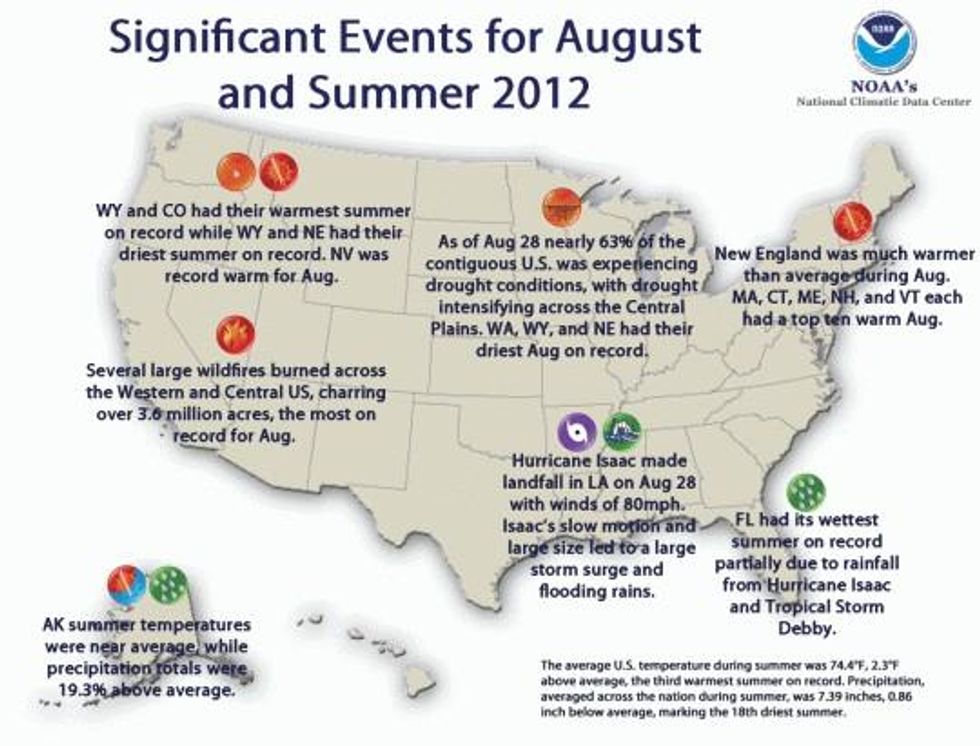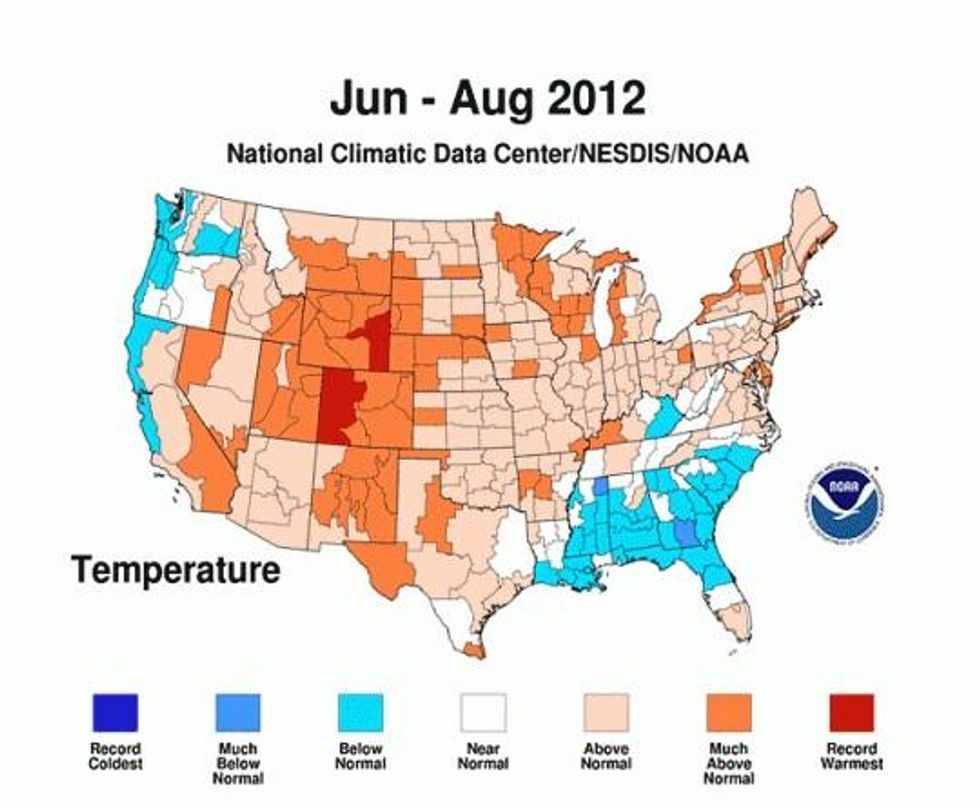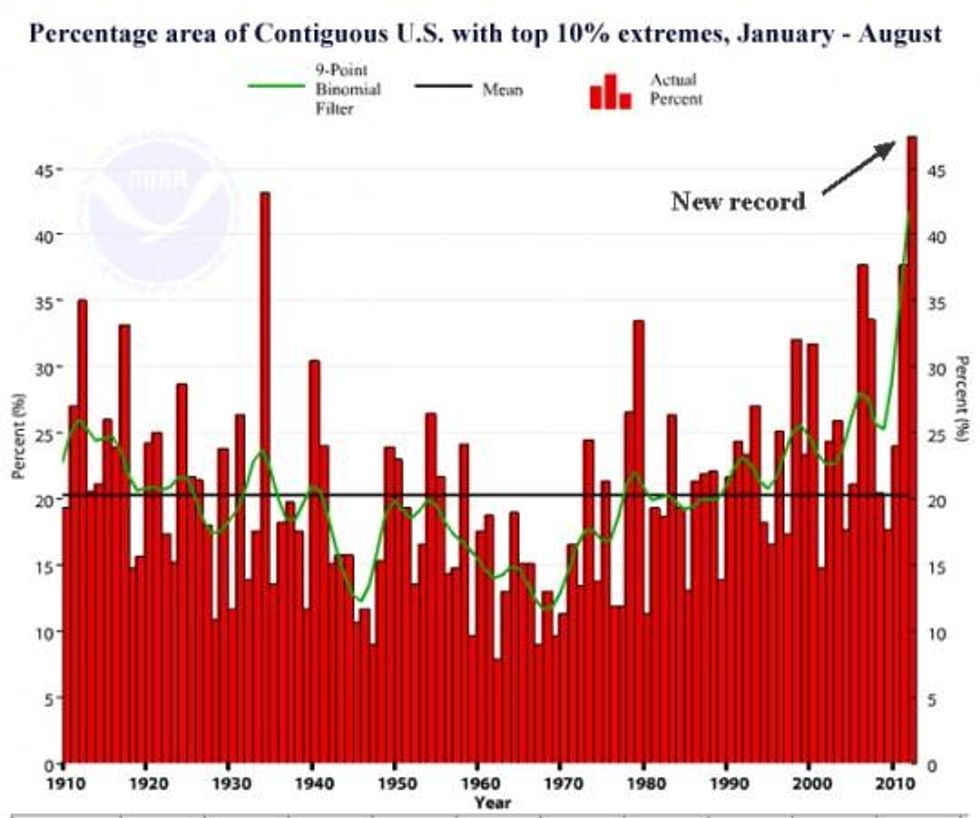US Just Experienced Warmest Year-to-Date Period Ever
Climate change continues to bring weather extremes
Climate change continues to bring extreme, record breaking weather to the U.S., according to the most recent calculations from the National Oceanic and Atmospheric Administration (NOAA) released Monday.
The contiguous U.S. just experienced the third hottest summer ever. And the year-to-date (Jan. - Aug.) period was also the warmest first 8 months ever recorded for the contiguous U.S.
The summer (June - Aug.) national average was 2.3degF above the 20th century average at 74.4degF, surpassed only by the summers of 2011 and 1936 for warmest summer in recorded history.
For the year-to-date period, the contiguous U.S. was 4.0degF above the 20th century average at 58.7degF, surpassing the previous record for this period set in 2006.
Adding to documentation of the manifestations of climate change, NOAA's U.S. Climate Extremes Index (CEI) shows the year-to-date period was also the most extreme on record. The NOAA describes the CEI as "an index that tracks the highest and lowest 10 percent of extremes in temperature, precipitation, drought and tropical cyclones across the contiguous U.S., was more than one and a half times the average value during summer 2012, and marked the eighth largest USCEI value for the season. Extremes in warm daytime temperatures, warm nighttime temperatures, and extremely dry conditions, according to the Palmer-Drought Severity Index, covered large areas of the nation, contributing to the high USCEI value."
Weather Underground co-founder Dr. Jeff Masters adds that the "CEI was 47% during the year-to-date January - August period. This is the highest value since CEI record-keeping began in 1910, and more than double the average value of 20%. Remarkably, 85% of the contiguous U.S. had maximum temperatures that were in the warmest 10% historically during the first eight months of 2012, and 75% of the U.S. of the U.S. had warm minimum temperatures in the top 10%."

* * *

* * *

An Urgent Message From Our Co-Founder
Dear Common Dreams reader, The U.S. is on a fast track to authoritarianism like nothing I've ever seen. Meanwhile, corporate news outlets are utterly capitulating to Trump, twisting their coverage to avoid drawing his ire while lining up to stuff cash in his pockets. That's why I believe that Common Dreams is doing the best and most consequential reporting that we've ever done. Our small but mighty team is a progressive reporting powerhouse, covering the news every day that the corporate media never will. Our mission has always been simple: To inform. To inspire. And to ignite change for the common good. Now here's the key piece that I want all our readers to understand: None of this would be possible without your financial support. That's not just some fundraising cliche. It's the absolute and literal truth. We don't accept corporate advertising and never will. We don't have a paywall because we don't think people should be blocked from critical news based on their ability to pay. Everything we do is funded by the donations of readers like you. Will you donate now to help power the nonprofit, independent reporting of Common Dreams? Thank you for being a vital member of our community. Together, we can keep independent journalism alive when it’s needed most. - Craig Brown, Co-founder |
Climate change continues to bring extreme, record breaking weather to the U.S., according to the most recent calculations from the National Oceanic and Atmospheric Administration (NOAA) released Monday.
The contiguous U.S. just experienced the third hottest summer ever. And the year-to-date (Jan. - Aug.) period was also the warmest first 8 months ever recorded for the contiguous U.S.
The summer (June - Aug.) national average was 2.3degF above the 20th century average at 74.4degF, surpassed only by the summers of 2011 and 1936 for warmest summer in recorded history.
For the year-to-date period, the contiguous U.S. was 4.0degF above the 20th century average at 58.7degF, surpassing the previous record for this period set in 2006.
Adding to documentation of the manifestations of climate change, NOAA's U.S. Climate Extremes Index (CEI) shows the year-to-date period was also the most extreme on record. The NOAA describes the CEI as "an index that tracks the highest and lowest 10 percent of extremes in temperature, precipitation, drought and tropical cyclones across the contiguous U.S., was more than one and a half times the average value during summer 2012, and marked the eighth largest USCEI value for the season. Extremes in warm daytime temperatures, warm nighttime temperatures, and extremely dry conditions, according to the Palmer-Drought Severity Index, covered large areas of the nation, contributing to the high USCEI value."
Weather Underground co-founder Dr. Jeff Masters adds that the "CEI was 47% during the year-to-date January - August period. This is the highest value since CEI record-keeping began in 1910, and more than double the average value of 20%. Remarkably, 85% of the contiguous U.S. had maximum temperatures that were in the warmest 10% historically during the first eight months of 2012, and 75% of the U.S. of the U.S. had warm minimum temperatures in the top 10%."

* * *

* * *

Climate change continues to bring extreme, record breaking weather to the U.S., according to the most recent calculations from the National Oceanic and Atmospheric Administration (NOAA) released Monday.
The contiguous U.S. just experienced the third hottest summer ever. And the year-to-date (Jan. - Aug.) period was also the warmest first 8 months ever recorded for the contiguous U.S.
The summer (June - Aug.) national average was 2.3degF above the 20th century average at 74.4degF, surpassed only by the summers of 2011 and 1936 for warmest summer in recorded history.
For the year-to-date period, the contiguous U.S. was 4.0degF above the 20th century average at 58.7degF, surpassing the previous record for this period set in 2006.
Adding to documentation of the manifestations of climate change, NOAA's U.S. Climate Extremes Index (CEI) shows the year-to-date period was also the most extreme on record. The NOAA describes the CEI as "an index that tracks the highest and lowest 10 percent of extremes in temperature, precipitation, drought and tropical cyclones across the contiguous U.S., was more than one and a half times the average value during summer 2012, and marked the eighth largest USCEI value for the season. Extremes in warm daytime temperatures, warm nighttime temperatures, and extremely dry conditions, according to the Palmer-Drought Severity Index, covered large areas of the nation, contributing to the high USCEI value."
Weather Underground co-founder Dr. Jeff Masters adds that the "CEI was 47% during the year-to-date January - August period. This is the highest value since CEI record-keeping began in 1910, and more than double the average value of 20%. Remarkably, 85% of the contiguous U.S. had maximum temperatures that were in the warmest 10% historically during the first eight months of 2012, and 75% of the U.S. of the U.S. had warm minimum temperatures in the top 10%."

* * *

* * *


